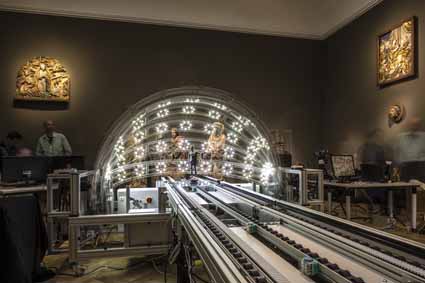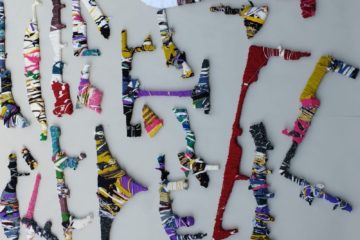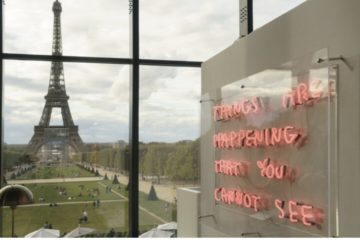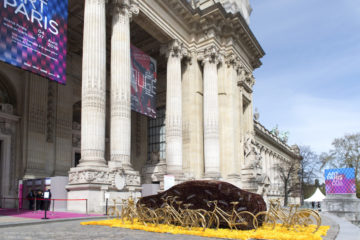GLOBALLY UNIQUE 3D SCANNER IN USE IN A MUSEUM FOR THE FIRST TIME – FRANKFURT LIEBIEGHAUS SKULPTURENSAMMLUNG

Fraunhofer technology for the preservation and documentation of cultural artefacts in operation at the Frankfurt Liebieghaus Skulpturensammlung
(Frankfurt am Main/Darmstadt, 23 July 2014) On Tuesday, 22 July 2014, for the first time in history, an art object was digitized in a fully automated process at Frankfurt’s Liebieghaus Skulpturensammlung with the globally unique CultLab3D scanning device developed by Fraunhofer IGD. Within a few minutes, Apollo Belvedere (1497/98) by Renaissance Sculptor Pier Jacopo Alari Bonacolsi (ca. 1460–1528), known as Antico, was scanned by the mobile digitization lab in the main hall of the museum’s
Medieval Department. Some eighty views from a wide range of angles together generated a 3D model of the more than 500-year-old sculpture, a digital record that can now be used for research, documentation and museum education purposes. This successful fully automated scan of a historical sculpture marks a turning point in the history of 3D digitization – a method hitherto very expensive and above all very time-consuming. The scanning and illumination technology of CultLab3D is revolutionizing the entire process of artefact digitization.
The fully automated mobile CultLab3D will permit the industrial, cost-effective and rapid threedimensional scanning of millions of artefacts in museum collections on site, as well as their permanent archiving and their digital availability worldwide for the purposes of research and education. CultLab3D not only records the objects’ geometry and surface texture, but also their optical material properties such as reflection and absorption characteristics. This technology thus makes photorealistic 3D illustration
possible. “CultLab3D represents the first economic and fast approach to the digitization of cultural artefacts in 3D”, observes Pedro Santos of Fraunhofer IGD. Santos and his team work on developing technologies for the efficient digitization and virtual reproduction of three-dimensional objects in top quality. “The conveyor-belt scanning device is an ideal application of high technology in the museum. In addition to the long-term documentation of objects, it also provides unlimited global digital access to art-historical contents and research results”, adds Max Hollein, director of the Liebieghaus Skulpturensammlung.
The artefacts pass through special scanning arcs on the CultLab3D system’s conveyor belt. On the way, they are scanned from all sides in a fully automated process. In a second step, scanners mounted on lightweight robotic arms fill in any remaining occlusions or gaps in the virtual 3D model. The entire process takes no more than a few minutes. The finished 3D model can then be linked to other data as well as information such as period of origin or artist.
The Liebieghaus Skulpturensammlung is a partner to the Fraunhofer research project and supports the development of 3D scanning technology with its expert knowledge in the area of research on polychromy. “The mobility of the scanning lab will allow museums to digitize their entire collections within a short time. This will provide researchers all over the world with entirely new means of scientific investigation. What is more, in cases of damage, an object can be reconstructed down to the smallest detail, or virtually reproduced”, comments Prof Dr Vinzenz Brinkmann, head of the Liebieghaus Skulpturensammlung’s Antiquity Department. The CultLab3D will remain in the Medieval Department of the Frankfurt Liebieghaus until Friday, 25 July 2014, scanning further sculptures as a basis for optimizing the automated digitization process. The exhibition hall will remain open to the visitors throughout the operation.
The CultLab3D received the award for the best technology exhibit at the Digital Heritage 2013 Conference in Marseille. The Fraunhofer IGD is the world’s leading institution for applied research in visual computing – the image and model-based branch of computer science. This discipline encompasses graphic data processing, computer vision, virtual and expanded reality, and much more; its practitioners obtain images from information and information from images. CultLab3D may be ready for marketing as early as the beginning of 2015.
Founded in 1909, the Liebieghaus Skulpturensammlung has in its possession more than three thousand works, making it one of the most important sculptural museums internationally. Its holdings unite outstanding sculptures dating from Ancient Egypt to Neoclassicism and including works of Egyptian, Greek and Roman antiquity, the Middle Ages and the Renaissance, Mannerism, the Baroque and the Rococo, Neoclassicism and Eastern Asia – a diversity enabling it to offer a well-founded survey of more than five thousand years of sculpture. In the past years, the Liebieghaus has attracted the interest of the general public and the acclaim of the experts with major exhibition and research projects such as “Gods in Color: Painted Sculpture of Classical Antiquity” (2008/09) or “Niclaus Gerhaert: The Medieval Sculptor” (2012).
Further information: www.cultlab3d.eu
Contact for CultLab3D: Dr Konrad Baier, presse@igd.fraunhofer.de, telephone: +49(0)6151-155-146
Liebieghaus Skulpturensammlung Press Department: Silke Janßen
Städel Museum, Dürerstraße 2, 60596 Frankfurt am Main, telephone: +49(0)69-605098-234,
fax: +49(0)69-605098-188, presse@liebieghaus.de, www.liebieghaus.de






No Comment